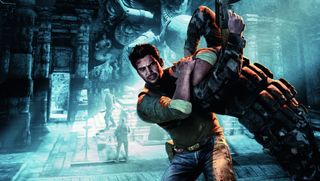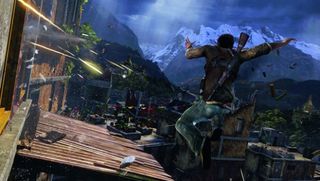Time Extend: Uncharted 2 - Among Thieves

The outgoing console generation’s legacy may very well be the perfection of the tightly focused ten-hour campaign. If you define it that way, then Uncharted 2: Among Thieves could claim to be the game of that generation; not the best game, but the one that is emblematic of tightly bound adventures built on the thrills of big worlds and bombastic set-pieces. Naughty Dog’s matinée revival has moments of technically astounding action; a lead character capable of carrying an almost unheard-of tonal range of tension, comedy and tragedy, where comparable blockbusters do anger as one long machine-gun burst; plus it embraces ideas of storytelling and entertainment that trigger a rare investment in its cast. It is, in other words, a beautiful game that is also very good at people.
Indeed, it’s accomplished at almost everything. Uncharted 2’s opening displays a casual confidence of craft and an eagerness for experimentation, breaking in at the story’s halfway point and reintroducing us to hero Nathan Drake with snapshot characterisation: he’s battered (“That’s my blood”), blithe (“That’s a lot of my blood”), and, suddenly, he’s upside down, a perspective yank turning a stationary train carriage into a vertiginous shaft. Drake plunges past seats and into the first of many hyperbolic translations of cinematic devices – here the teetering mountainside vehicle, but later a moving train, the unpinned grenade, and last-gasp fingertip handholds.
There’s something overtly cinematic in that opening: the formalist interruption, a trick instinctively taken from the splice-and-join of film editing; the precariousness of the train, a literal cliffhanger. And it’s generally agreed there’s something overtly cinematic in Uncharted 2 itself. The game is sandy adventure and sunset romance as seen down the sights of a pistol or on flickering screens since long before Indiana Jones, harking back to the time of Gunga Din. It is also the problematic culmination of Hollywood’s decades-long flirtation with games in the obsessive search for synergy.
All of which is to say that Uncharted 2 not only bears highly visible influences from the movies, the basic colour of its world taken from the themes and tokens of big-screen romantic adventure, but that Naughty Dog’s reverence for story might have produced the closest thing to convergence between film and games that doesn’t involve a cabinet spinning a LaserDisc to create a cartoon dragon. The studio has embraced the craft of storytelling as taught by the film industry, and emerged with a new production process that devotes a sustained, expensive amount of time (the irony of that synergistic urge – there is no shortcut to convergence) to performance capture, to workshopping and rehearsal with actors on a digital soundstage.

The result is not a revolution. Uncharted 2 does not solve the inelegance of the cutscene, and still needs to interrupt itself in order to tell a story. And it does not broaden the corridors of that tightly focused ten-hour experience – the game is relentlessly linear, a gilded cage of invisible walls and beautifully textured boundaries. This is where Uncharted 2’s cinematic-ness slides from cool observation to criticism. Is it even a game, really? It’s so on-rails.
Let’s talk about trains, since we seem to be back on one. Walter Murch, editor of Apocalypse Now, once drew a link between the railway and film, between clickety-clack technologies that run along tracks and their shared sense of perception and mechanical possibility. It is, he said, to do with a way of seeing the world. “There is the idea of the voyage. Every voyage is a story.”
This idea runs through Uncharted 2. The train wrecked and suspended in that opening is reanimated to become the major action beat of the game’s second act, where it carries Drake on a journey to catch up with his own story. Consciously or not – and it’s hard to think it could have been totally unintentional – Uncharted 2 has internalised one of the great symbols of cinema, one of the first objects to be filmed in Lumière’s L’arrivée D’un Train En Gare De La Ciotat, scattering apocryphal audiences terrified of the onrushing engine, and the heaving iron horse central to the Western. But the train is also a symbol of this generation’s great form, the focused, ten-hour singleplayer campaign – these rails might leave little room for deviation, but they offer a hell of a ride. This is still a game, just a different form of play, one closer to the cinema, built on spectatorship and sympathy, an act of mimesis.
Sign up to the GamesRadar+ Newsletter
Weekly digests, tales from the communities you love, and more
When it’s not being a symbol of ambition and convergence, Drake’s train journey is the most astonishing few minutes of play on PS3. The train rattles through a jungle so apparently endless it ceases to be anything other than real, while Drake leaps, slugs and hip-fires his way from carriage to carriage, everything feeling detached and independent, dynamic and precarious. This is something Uncharted 2 does with confounding regularity: delivers moments that are impossible to play without clocking a jolt of conspicuous technical achievement. It’s there in the opening, as the camera rushes outward to reveal a cavernous drop and Himalayan scale. It’s there as Drake is hounded by a helicopter over the baking rooftops of Kathmandu, racing through capsizing buildings and into impossible landings. And it’s there as a tank attacks a mountain-top village, punching through stone-stacked houses and chasing Drake along walls and up stairways with spitting rakes of machine-gun fire. Uncharted 2 emerges from Naughty Dog’s conception of itself as a company. It’s a company that tells stories, but also one driven by technology and a belief that technological achievement, spectacle, can be beautiful in its own right.

Ultimately, though, what makes Uncharted 2 truly remarkable are its people, who are as bright and memorable as any of the things that crash or blow up inside it. Take Tenzin the Tibetan Sherpa, who finds Drake in the snow following his train derailment and brings the injured stranger to his village in the Himalayas (and then, admittedly, helps him blow up that tank). His wordless friendship with Drake is forged in a single level (and not even one of the game’s best), traversing ice caverns and encountering yetis, a sense of trust built through cooperation. The relationship is inspired by Ico, PS2’s fairytale of companions and castles, and went on to inform The Last Of Us. It’s an act of emotional play, of attachment and sympathy – and this sympathy, the game discovers, provides a more urgent motivation for gameplay than any regular power fantasy or destructive urge. When the tank arrives, it threatens Tenzin’s daughter, and destroying it becomes an act of loyalty – it’s not meaningless fury, but directed, nuanced outrage. This is cinematic play.
As well as mystical mountain men, Uncharted 2 also delivers on overlooked basics. The women in Drake’s life are unusually formidable. Chloe, played by Claudia Black, is marked by an uncommon depth of motivation. She’s not defined by her feelings towards Drake, but ambiguously attracted to him, another man and, crucially, her own best interests. She’s believable, unpredictable, and dangerous. On the other hand, series mainstay Elena, played by Emily Rose, is a blonde love interest in a game about guns and endless action. But she’s also sceptical and strong, and so when the series does finally bring her and Drake together romantically at the close of this game – the first didn’t consider it essential – it feels earned and touching. Their relationship is a two-way street of humour and humanity, and is a greater payoff than any climactic boss battle.
At the very epicentre of Uncharted 2’s achievement is Nathan Drake himself. He is not only likeable, but well liked. This is no easy thing to achieve in videogames, and it makes so many others possible. Bland heroes proliferate because of the dangerous logic that we’d rather play as polite aggregations of nothing in particular than as people who are definitely not us. Drake overflows with personality – a function of smart writing, but also, it’s hard not to think, of a performance process that gives the game’s actors, and Nolan North in particular, a chance to pour more of themselves into each character.
When Tenzin brings Drake back to his village, and after his recuperation, Drake wakes up and wanders through the houses, mountains on every side. As he meets Tenzin’s people, the button for a melee attack becomes the button to shake hands, or to salute, or to play football with children. Just for a few moments, a square-jawed hero is capable of interacting with his surroundings by reaching out and making connections rather than swinging fists and breaking faces. And just for a moment, Nathan Drake gets to simply exist. It’s so quiet in the village. He can stand and breathe. He can smile and be human.
This is to call attention to Uncharted 2’s storytelling and all-round craft, rather than a suggestion that humanitarian positivism is the bedrock of acing the thirdperson shooter. And it’s certainly not an attempt to reconcile the contradiction of this being the standout moment of a game about killing hundreds of soldiers – it can’t be done, and Uncharted 2 doesn’t have all of the answers. But it does have the imagination to offer us the possibility that things could be different, and it remains remarkable as a game driven by technology that succeeds on the grounds of its humanity.
Edge magazine was launched in 1993 with a mission to dig deep into the inner workings of the international videogame industry, quickly building a reputation for next-level analysis, features, interviews and reviews that holds fast nearly 30 years on.
Most Popular





